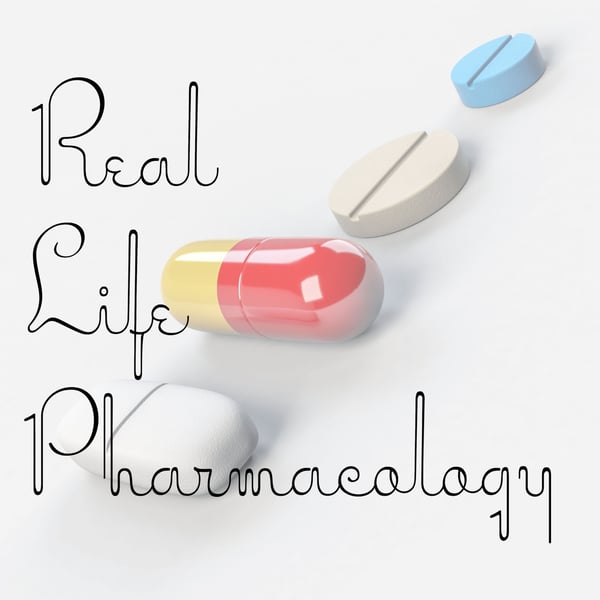Cetirizine Pharmacology
Real Life Pharmacology - Pharmacology Education for Health Care Professionals
Eric Christianson, PharmD; Pharmacology Expert and Clinical Pharmacist
5 • 716 Ratings
🗓️ 17 June 2021
⏱️ 12 minutes
🧾️ Download transcript
Summary
Cetirizine, commonly known as Zyrtec, is a 2nd generation antihistamine. Compared to 1st generation antihistamines, like diphenhydramine and chlorpheniramine, 2nd generation antihistamines have fewer anticholinergic effects. Pharmacologically, cetirizine works by selectively blocking histamine from binding to the H1 receptor. The uses for cetirizine are allergic rhinitis, itching, and sometimes acute allergic reactions. Commonly, cetirizine is dosed at 10 mg daily, and can even be escalated to 10 mg twice daily in rare situations. In adults 77 years old and older, the manufacturer recommended dose tops out at 5 mg daily. There are also liquid and chewable formulations for children.
The adverse drug reactions cetirizine are mostly dose-dependent and related to its pharmacology. Out of all of the 2nd generation antihistamines, like fexofenadine and loratadine, cetirizine is the most sedating. Other adverse drug reactions related to its anticholinergic effects are urinary retention, constipation, confusion, fatigue, and dizziness. Lab monitoring is not necessary when taking cetirizine. It is important to monitor the adverse drug reactions when taking cetirizine, as well as improvement in the signs and symptoms of what it’s used for.
Cetirizine does not undergo metabolism through liver CYP enzymes, so drug-drug interactions involving those enzymes are uncommon. The interactions that are concerning are additive effects of cetirizine’s adverse drug reactions. Drowsiness can be compounded when cetirizine is taken with opioids, sleep medications, alcohol, or other older anticholinergics with sedative effects. There is also a risk of an increased anticholinergic burden when taking medications like Cogentin, oxybutynin, TCAs, and inhaled anticholinergics.
The manifestation of overdoses will vary depending on age. In adults, the most common observation made was sedation and somnolence. In children, restlessness and irritability were observed initially, then drowsiness. Cetirizine is not removed by dialysis. When treating overdoses, the symptoms that manifest should be treated.
Show notes provided by Chong Yol G Kim, PharmD Student.
Transcript
Click on a timestamp to play from that location
| 0:00.0 | Hey all, welcome back to the Real Life Pharmacology podcast. I'm your host, pharmacist, Eric Christensen. |
| 0:06.0 | Thank you for listening today. Go check out Real Life Pharmacology.com. |
| 0:11.7 | Snag a free 31-page PDF on the top 200 drugs. |
| 0:16.0 | Great little study guide if you're going through board exams, pharmacology exams, final exams, things like that. So |
| 0:22.1 | definitely don't hesitate to snag that for free. Simply an email. We'll get you access to that. |
| 0:28.2 | And then, of course, we'll get you updates on when we've got new podcasts out, which are usually on a |
| 0:32.4 | weekly basis, as well as any other new content as well. So again, real-life pharmacology.com. |
| 0:39.1 | Go check that out. |
| 0:40.9 | All right. |
| 0:41.2 | So let's talk about the drug of the day today. |
| 0:44.6 | Ceturazine. |
| 0:45.8 | Brand name of this medication is Zyrtec. |
| 0:49.1 | It is classified as an antihistamine. |
| 0:52.5 | So I have covered some antihistamines in the past, particularly |
| 0:57.5 | more so some of the first generation antihistamines, such as hydroxazine, diphenhydramine. |
| 1:07.9 | Now, citerazine differs from those and that it is classified as a second generation antihistamine. |
| 1:16.1 | And the biggest thing with second generation antihistamines, and I'll get into it when I talk about |
| 1:22.5 | adverse effects a little bit, is they have generally less anticholinergic adverse effects. So that's definitely a good |
| 1:31.2 | thing because there's plenty of issues with that if you've listened to the, you know, |
| 1:35.6 | Benadryl and the hydroxazine podcast in the past. So being an antihistamine, |
| 1:43.1 | allergies is probably the primary reason that I'm going to see a |
| 1:47.6 | patient on this for an extended period of time. |
... |
Please login to see the full transcript.
Disclaimer: The podcast and artwork embedded on this page are from Eric Christianson, PharmD; Pharmacology Expert and Clinical Pharmacist, and are the property of its owner and not affiliated with or endorsed by Tapesearch.
Generated transcripts are the property of Eric Christianson, PharmD; Pharmacology Expert and Clinical Pharmacist and are distributed freely under the Fair Use doctrine. Transcripts generated by Tapesearch are not guaranteed to be accurate.
Copyright © Tapesearch 2025.

